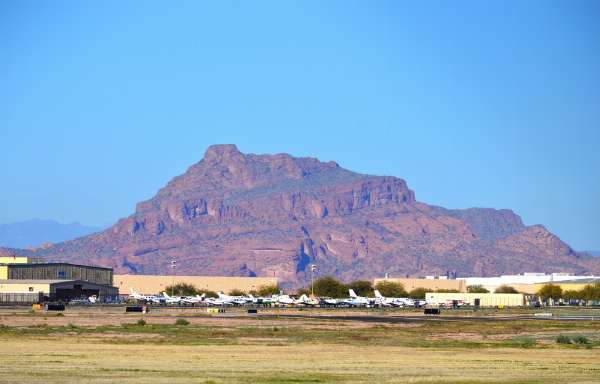Mesa, Arizona, has been making waves in the broadband industry because a whopping six players are prepped to build fresh fiber infrastructure in the city. They’re all eyeing the prize of gaining market share with city residents. Mesa is yet another market seeing a handful of major broadband competitors vying for the same territory, but due to the sheer amount of them, what’s happening in the city is an important experiment.
Will fiber be faster and cheaper because of the competition? Is Mesa setting the stage for what may happen in other dense, competitive markets? Is the boom in competition due only to the influx of $42.45 billion in Broadband Equity, Access, and Deployment (BEAD) Program funds? Here’s why what’s happening in Mesa is so significant.
Who Are the Six Fiber Internet Competitors?
As of Jan. 31, six fiber internet competitors have secured contracts to build fiber infrastructure in Mesa, Arizona: SiFi Networks, Google Fiber, Wyyerd, Generate Ubiquity, Lumen Technologies, and AT&T. This doesn’t include other contracts that may be awarded to more ISPs in wider Maricopa County — Mesa’s county seat.
While it’s hard to say who will go to the top of the pack in Mesa, part of what differentiates one provider from another is what its current fiber footprints look like.
AT&T
Most Americans have access to AT&T internet services via historic DSL (now a copper-fiber hybrid called IPBB) connections. However, the provider is ready to spread its wings in Mesa. AT&T’s existing fiber footprint is primarily in Alabama, Arkansas, and California.
Google Fiber
Google Fiber’s current fiber reach is in pockets of Texas, Kansas, and Missouri. It’s especially prominent in Kansas City. The existing fiber network availability pales in comparison to other major providers, but Google Fiber offers some of the fastest speeds currently available.
SiFi Networks
SiFi Networks is in the process of building out fiber projects in a handful of states across the country. Specifically, it has a range of cities in California on its plate. Other centers of construction are in Florida.
Wyyerd
Wyyerd is currently focused on expanding its reach in the Arizona market. Its current footprint includes over 12,000 customers in Peoria, Arizona. Mesa would be a substantial expansion into the state.
Generate Ubiquity
Generate Ubiquity has launched projects across concentrated pockets of the West. Specifically, it has expanded into California and Texas. Mesa would be its first foray into the Arizona market.
Lumen Technologies
Lumen Technologies has approximately 400,000 global miles of fiber in its network. It snakes across Europe, Africa, Asia, Australia, and North America. Its existing fiber touches down in the majority of states across the U.S.
Why Mesa, Arizona?
Mesa is the third-largest city in Arizona, behind Phoenix and Tucson. It’s the second-largest city in Maricopa County as a suburb of nearby Phoenix. While Mesa is only a 20-minute drive away from the sprawling metropolis, according to 2021 census estimates, over half a million people live within the municipality of Mesa alone.
With a population hovering around 4.4 million people, Maricopa County has grown by nearly half a million people over the past 10 years. Mesa alone grew by 65,000 residents in that same time frame. Of the residents who moved to Arizona in 2022, over 40 percent earn $150,000 or more annually.
Right now, Mesa is a hotbed of migration and money. Fresh ISP construction for households beyond current broadband footprints is a necessity. But what has truly distinguished Mesa from similar locales is that the city council has prioritized closing the digital divide in the city for the past decade. That focus was heightened after COVID-19 and the shift toward remote work.
In January 2022, the city released a request for information from ISPs to gather proposals for fiber construction. One by one, the competitors lined up. Between upcoming BEAD Program fund disbursement and the openness of the Mesa market, the city may be a proving ground for up-and-coming fiber installers.
How Will the Fiber Competition Play Out?

Mesa already has incumbent ISPs who have their own strongholds on the market: Cox and CenturyLink. Cox offers cable service to nearly 100 percent of the city. CenturyLink offers fiber, but its coverage is limited compared to its DSL service. Part of why there’s a push for fiber internet is because it’s a faster service. It offers symmetrical upload and download speeds, which can power American households accustomed to streaming, gaming, and remote working. It’s just a question of getting the infrastructure (and by extension, more coverage) established.
The challenge with so many providers building out fiber infrastructure in one space is they may end up overbuilding the market. Overbuilding is when one fiber network constructs its network on top of, or in the nearby vicinity of, an existing, incumbent provider. Eventually, that infrastructure will outweigh consumer needs, and a portion of it will go under or unused. Historically, this was the case with projects like railroads in the U.S.
Overbuilding tends to be controversial in the broadband industry. One concern is that too many networks will overlap each other and be costly and wasteful. This is important to keep in mind since funding may come into these projects from the BEAD Program pipeline. On the other hand, overbuilding can provide more market options for fiber and create more infrastructure to meet the needs of places with growing populations. That may come with economic strain and regulatory challenges now, but the competition may help decrease costs and increase quality for consumers at the end of the day.
If providers want to avoid building fresh fiber networks on top of one another, they’ll need to collaborate and parse out specific areas and neighborhoods. That way, they can cover one another’s gaps. It’s unclear if that type of communication will actually occur among competitors.
Experts note it’s unlikely that all six fiber players in Mesa will remain in the market. Providers don’t receive market share equally, so it’s possible that the market will be viable for only three competitors. Nonetheless, people are waiting to see what this market competition may illuminate for other burgeoning broadband markets across the U.S.


